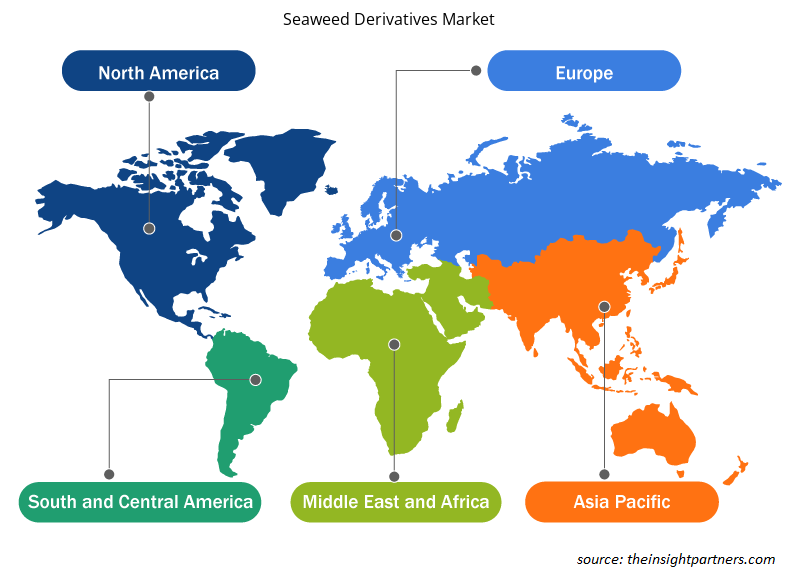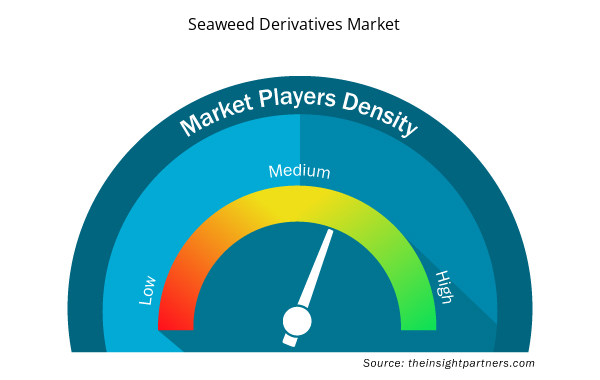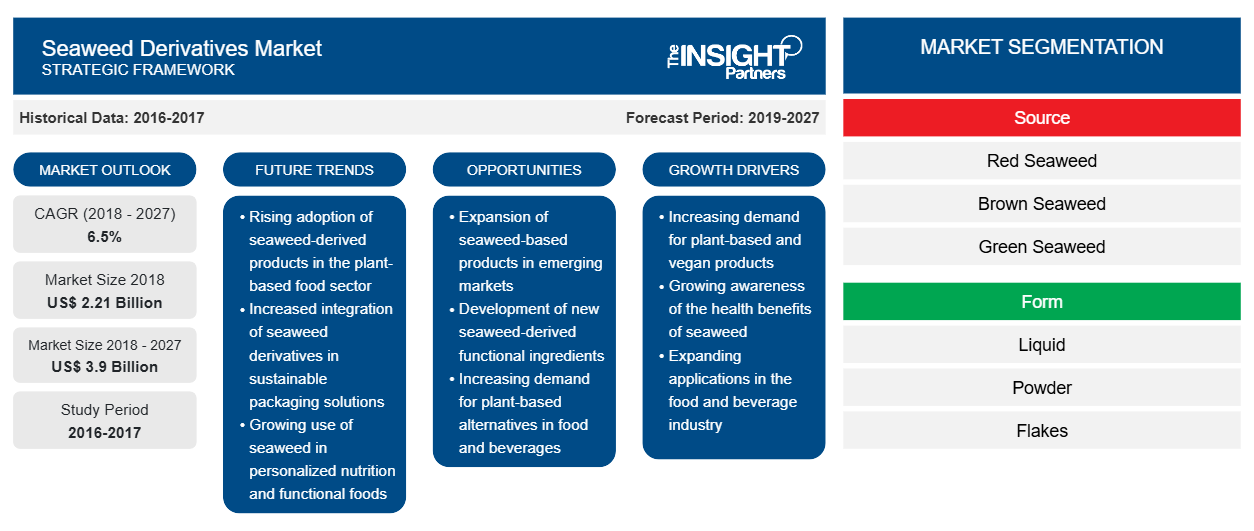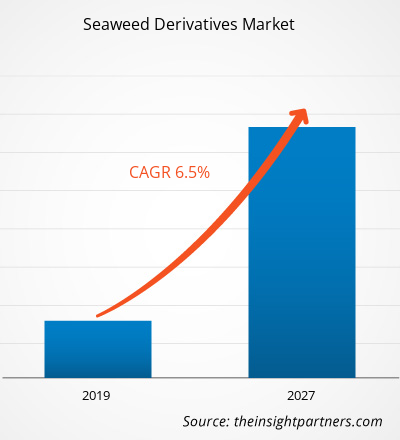Il mercato dei derivati delle alghe è stato valutato 2.210,35 milioni di dollari nel 2018 e si prevede che raggiungerà i 3.903,91 milioni di dollari entro il 2027; si prevede una crescita a un CAGR del 6,5% dal 2019 al 2027.
Le alghe sono fondamentalmente microalghe marine rosse, marroni e verdi, i cui estratti sono utilizzati nelle colture orticole per i loro effetti di promozione della crescita delle piante. I derivati chimici delle alghe includono acidi grassi e vitamine, nutrienti minerali, fitoarmoni e polisaccaridi complessi, tra gli altri. I principali derivati delle alghe includono alginati, carragenine e agar. Gli alginati sono in gran parte estratti dalle alghe marroni, mentre le carragenine e gli agar sono in gran parte estratti dalle alghe rosse. Alginati, carragenine e agar sono sempre più utilizzati nell'industria alimentare e delle bevande, dei mangimi per animali e dell'agricoltura, tra gli altri.
Nel 2018, l'Asia Pacifica ha detenuto la quota maggiore nel mercato globale dei derivati delle alghe , seguita da Europa e Nord America. La crescente domanda da parte dell'industria alimentare e delle bevande, dei mangimi per animali e dell'agricoltura sta principalmente guidando il mercato nella regione Asia Pacifica. Cina, Corea del Sud e Giappone sono i principali produttori e consumatori di derivati delle alghe nella regione Asia Pacifica. Il mercato è principalmente guidato dalla più ampia applicazione dei derivati delle alghe nell'industria alimentare e delle bevande. Viene sempre più utilizzato nei fertilizzanti, il che migliora la resa delle colture e aumenta la resistenza delle colture, il che aiuta nella resistenza ai parassiti. La crescente consapevolezza dei consumatori riguardo ai benefici per la salute dei derivati delle alghe sta aumentando notevolmente il mercato delle alghe. Inoltre, la crescente domanda di prodotti alimentari biologici alimenta la crescita del mercato dei derivati delle alghe. Una minore consapevolezza tra gli agricoltori riguardo all'estrazione delle alghe sta resistendo alla crescita del mercato dei derivati delle alghe.
L'epidemia di COVID-19 è iniziata a Wuhan (Cina) nel dicembre 2019 e da allora si è diffusa rapidamente in tutto il mondo. Cina, Italia, Iran, Spagna, Repubblica di Corea, Francia, Germania e Stati Uniti sono tra i paesi più colpiti in termini di casi positivi e decessi segnalati a marzo 2020. L'epidemia di COVID-19 ha colpito economie e industrie in vari paesi a causa di blocchi, divieti di viaggio e chiusure aziendali. L'industria alimentare e delle bevande globale è una delle principali industrie che ha subito gravi interruzioni come interruzioni della catena di fornitura, cancellazioni di eventi tecnologici e chiusure di uffici a causa di questa epidemia. Ad esempio, la Cina è il polo manifatturiero globale e il più grande fornitore di materie prime per vari settori. La crisi generale del mercato dovuta al COVID-19 sta influenzando anche la crescita del mercato dei derivati delle alghe a causa della chiusura delle fabbriche, degli ostacoli nella catena di fornitura e della crisi dell'economia mondiale.
Personalizza questo report in base alle tue esigenze
Riceverai la personalizzazione gratuita di qualsiasi report, comprese parti di questo report, o analisi a livello nazionale, pacchetto dati Excel, oltre a usufruire di grandi offerte e sconti per start-up e università
- Scopri le principali tendenze di mercato in questo rapporto.Questo campione GRATUITO includerà analisi di dati che spaziano dalle tendenze di mercato alle stime e alle previsioni.
Approfondimenti di mercato
La crescente domanda da parte dell'industria alimentare e delle bevande ha favorito il mercato dei derivati delle alghe a livello globale
I derivati delle alghe come agar, alginati e carragenine sono ampiamente utilizzati in vari prodotti alimentari e bevande. Questi derivati sono utilizzati in un'ampia gamma di alimenti e bevande come gelato, sciroppo, salumi, latte in polvere per neonati, latte di mandorle, panna montata, barrette di cioccolato, latte al cioccolato, bevande al caffè (ad esempio, caffè freddo e bevande al caffè a base di soia), panna da caffè, ricotta, yogurt, ricotta e panna acida, tra gli altri. Le carragenine sono utilizzate come ingrediente addensante in budini, latte al cioccolato, gomme da masticare, marmellate e gelatine. Inoltre, le carragenine riducono gli sprechi prolungando la durata di conservazione degli alimenti senza alcuna perdita di qualità. Vari alimenti, come maionese e condimento per insalata, si separerebbero senza l'aiuto di uno stabilizzante. Pertanto, la carragenina è utilizzata come agente stabilizzante nella maionese e nel condimento per insalata. Pertanto, un'ampia gamma di applicazioni di derivati delle alghe nell'industria alimentare e delle bevande stimola la crescita del mercato dei derivati delle alghe a livello globale.
Informazioni sulla fonte
In base alla fonte, il mercato dei derivati delle alghe è segmentato in alghe rosse, alghe brune e alghe verdi. Nel 2018, il segmento delle alghe rosse ha rappresentato la quota maggiore del mercato globale dei derivati delle alghe. Le alghe rosse tendono a possedere i livelli proteici più elevati, che sono responsabili del loro colore rosso. Nonostante si trovino in acque poco profonde, le alghe rosse sono in grado di resistere alle acque profonde e alle condizioni di scarsa illuminazione. Questi fattori stimolano la crescita del mercato dei derivati delle alghe rosse.
Informazioni sul modulo
In base alla forma, il mercato dei derivati delle alghe è segmentato in liquido, polvere e scaglie. Nel 2018, il segmento liquido ha rappresentato la quota maggiore del mercato globale dei derivati delle alghe; tuttavia, si prevede che il segmento delle polveri registrerà il tasso di crescita più rapido durante il periodo di previsione. I derivati liquidi delle alghe brune sono commercializzati per l'uso in orticoltura e agricoltura. I derivati liquidi delle alghe sono utilizzati ad alti tassi di diluizione, il che si traduce in quantità minime di materiale applicate nell'area data. Le sostanze attive nei derivati liquidi delle alghe sono in grado di influenzare temperature così basse.
Informazioni sull'uso finale
In base all'uso finale, il mercato dei derivati delle alghe è segmentato in alimenti e bevande, prodotti agricoli, additivi per mangimi animali, prodotti farmaceutici e altri. Nel 2018, il segmento degli alimenti e delle bevande ha rappresentato la quota maggiore del mercato globale dei derivati delle alghe; tuttavia, si prevede che il segmento degli additivi per mangimi animali registrerà il tasso di crescita più rapido durante il periodo di previsione. I derivati delle alghe come gli alginati sono ampiamente utilizzati nei prodotti da forno, caramelle, latticini, condimenti per insalata, gelati, creme e gelatine, nonché in salsicce, carni lavorate e pesce. Sono anche utilizzati per chiarificare birre e vini. Gli alginati sono completamente organici e sono una sostanza sicura per l'applicazione alimentare. Inoltre, gli alginati sono in grado di addensare una soluzione quando vengono sciolti in acqua. Inoltre, gli alginati possono formare gel quando vengono aggiunti a una soluzione di sale di calcio. Pertanto, gli alginati sono utilizzati principalmente nei condimenti per insalata e nella maionese.
Approfondimenti regionali sul mercato dei derivati delle alghe
Le tendenze regionali e i fattori che influenzano il mercato dei derivati delle alghe durante il periodo di previsione sono stati ampiamente spiegati dagli analisti di Insight Partners. Questa sezione discute anche i segmenti e la geografia del mercato dei derivati delle alghe in Nord America, Europa, Asia Pacifico, Medio Oriente e Africa e America meridionale e centrale.

- Ottieni i dati specifici regionali per il mercato dei derivati delle alghe
Ambito del rapporto di mercato sui derivati delle alghe
| Attributo del report | Dettagli |
|---|---|
| Dimensioni del mercato nel 2018 | 2,21 miliardi di dollari USA |
| Dimensioni del mercato entro il 2027 | 3,9 miliardi di dollari USA |
| CAGR globale (2018 - 2027) | 6,5% |
| Dati storici | 2016-2017 |
| Periodo di previsione | 2019-2027 |
| Segmenti coperti | Per fonte
|
| Regioni e Paesi coperti | America del Nord
|
| Leader di mercato e profili aziendali chiave |
|
Densità degli attori del mercato: comprendere il suo impatto sulle dinamiche aziendali
Il mercato dei derivati delle alghe sta crescendo rapidamente, spinto dalla crescente domanda degli utenti finali dovuta a fattori quali l'evoluzione delle preferenze dei consumatori, i progressi tecnologici e una maggiore consapevolezza dei benefici del prodotto. Con l'aumento della domanda, le aziende stanno ampliando le loro offerte, innovando per soddisfare le esigenze dei consumatori e capitalizzando sulle tendenze emergenti, il che alimenta ulteriormente la crescita del mercato.
La densità degli operatori di mercato si riferisce alla distribuzione di aziende o società che operano in un particolare mercato o settore. Indica quanti concorrenti (operatori di mercato) sono presenti in un dato spazio di mercato in relazione alle sue dimensioni o al valore di mercato totale.
Le principali aziende che operano nel mercato dei derivati delle alghe sono:
- W Idrocolloidi, Inc.
- Società KIMICA
- DuPont de Nemours, Inc.
- Società Gelymar SA
- CP Kelco
Disclaimer : le aziende elencate sopra non sono classificate secondo un ordine particolare.

- Ottieni una panoramica dei principali attori del mercato dei derivati delle alghe
Mercato globale dei derivati delle alghe – Per fonte
- Alga rossa
- Alga bruna
- Alga verde
Mercato globale dei derivati delle alghe – Per forma
- Liquido
- Polvere
- Fiocchi
Mercato globale dei DERIVATI DELLE ALGHE – Per uso finale
- Cibo e bevande
- Prodotti agricoli
- Additivi per mangimi animali
- Prodotti farmaceutici
- Altro uso finale
Profili aziendali
- W Idrocolloidi, Inc.
- Società KIMICA
- DuPont de Nemours, Inc.
- Società Gelymar SA
- CP Kelco
- ALGAIA
- Compañía Española de Algas Marinas, SA
- Cargill, Incorporata
- ARTHUR BRANWELL & CO
- AGARMEX, SA DI CV
- Analisi storica (2 anni), anno base, previsione (7 anni) con CAGR
- Analisi PEST e SWOT
- Valore/volume delle dimensioni del mercato - Globale, regionale, nazionale
- Industria e panorama competitivo
- Set di dati Excel



Report Coverage
Revenue forecast, Company Analysis, Industry landscape, Growth factors, and Trends

Segment Covered
This text is related
to segments covered.

Regional Scope
North America, Europe, Asia Pacific, Middle East & Africa, South & Central America

Country Scope
This text is related
to country scope.
Domande frequenti
In 2018, the seaweed derivatives market was predominant by Asia-Pacific at the global level.Rising concerns about healthy food due to the overweight and obese population as well as rising prevalence of chronic diseases, such as diabetes, hypertension, cardiac issues, and orthopedic diseases, are a few more factors driving the seaweed derivatives market in this region.. Growing awareness about the health benefits and increasing seaweed derivatives usage in the personal care sector is driving the market growth in the region.People in China, Japan, and South Korea have cultivated and harvested seaweed for food and other industrial uses for hundreds of years. Seaweed derivatives are used in textile ink for more than 1000 years. The Asia Pacific has become a lucrative region, which has witnessed an increase in the investment among the manufactures related to several industries such as food and beverage, personal care, and pharmaceutical, amongst others. The growth of these industries is positively expected to expand the demand for seaweed derivatives products in the region.
Among all three segments of source, the red seaweedsegment has led the market in 2018 and is expected to be the dominant segment in the near future.The red seaweed is large branched plants or bushy growths on shellfish and rocks. It makes up the largest group of algae in the plant kingdom, with more species compared to green and brown seaweeds. The main Form of red seaweed is as a source of two hydrocolloids, namely, agar and carrageenan, and the second one is as a source of food. Red seaweed is a marine plant exclusively. Red seaweed tends to possess the highest protein levels, which are responsible for its red color.
The major players operating in the globalseaweed derivativesmarketareW Hydrocolloids, Inc., KIMICA Corporation, DuPont de Nemours, Inc., Gelymar S.A., CP Kelco, Algaia, and Cargill Incorporated, CompañÃa Española de Algas Marinas, S.A., Arthur Branwell & Co., Agarmex, S.A. DE C.V., and among many others.
Trends and growth analysis reports related to Consumer Goods : READ MORE..
The List of Companies - Seaweed Derivatives Market
- W Hydrocolloids, Inc.
- KIMICA Corporation
- DuPont de Nemours, Inc.
- Gelymar S.A.
- CP Kelco
- Algaia
- Compañía Española de Algas Marinas, S.A.
- Cargill, Incorporated
- Arthur Branwell & Co
- Agarmex, S.A. DE C.V
The Insight Partners performs research in 4 major stages: Data Collection & Secondary Research, Primary Research, Data Analysis and Data Triangulation & Final Review.
- Data Collection and Secondary Research:
As a market research and consulting firm operating from a decade, we have published and advised several client across the globe. First step for any study will start with an assessment of currently available data and insights from existing reports. Further, historical and current market information is collected from Investor Presentations, Annual Reports, SEC Filings, etc., and other information related to company’s performance and market positioning are gathered from Paid Databases (Factiva, Hoovers, and Reuters) and various other publications available in public domain.
Several associations trade associates, technical forums, institutes, societies and organization are accessed to gain technical as well as market related insights through their publications such as research papers, blogs and press releases related to the studies are referred to get cues about the market. Further, white papers, journals, magazines, and other news articles published in last 3 years are scrutinized and analyzed to understand the current market trends.
- Primary Research:
The primarily interview analysis comprise of data obtained from industry participants interview and answers to survey questions gathered by in-house primary team.
For primary research, interviews are conducted with industry experts/CEOs/Marketing Managers/VPs/Subject Matter Experts from both demand and supply side to get a 360-degree view of the market. The primary team conducts several interviews based on the complexity of the markets to understand the various market trends and dynamics which makes research more credible and precise.
A typical research interview fulfils the following functions:
- Provides first-hand information on the market size, market trends, growth trends, competitive landscape, and outlook
- Validates and strengthens in-house secondary research findings
- Develops the analysis team’s expertise and market understanding
Primary research involves email interactions and telephone interviews for each market, category, segment, and sub-segment across geographies. The participants who typically take part in such a process include, but are not limited to:
- Industry participants: VPs, business development managers, market intelligence managers and national sales managers
- Outside experts: Valuation experts, research analysts and key opinion leaders specializing in the electronics and semiconductor industry.
Below is the breakup of our primary respondents by company, designation, and region:

Once we receive the confirmation from primary research sources or primary respondents, we finalize the base year market estimation and forecast the data as per the macroeconomic and microeconomic factors assessed during data collection.
- Data Analysis:
Once data is validated through both secondary as well as primary respondents, we finalize the market estimations by hypothesis formulation and factor analysis at regional and country level.
- Macro-Economic Factor Analysis:
We analyse macroeconomic indicators such the gross domestic product (GDP), increase in the demand for goods and services across industries, technological advancement, regional economic growth, governmental policies, the influence of COVID-19, PEST analysis, and other aspects. This analysis aids in setting benchmarks for various nations/regions and approximating market splits. Additionally, the general trend of the aforementioned components aid in determining the market's development possibilities.
- Country Level Data:
Various factors that are especially aligned to the country are taken into account to determine the market size for a certain area and country, including the presence of vendors, such as headquarters and offices, the country's GDP, demand patterns, and industry growth. To comprehend the market dynamics for the nation, a number of growth variables, inhibitors, application areas, and current market trends are researched. The aforementioned elements aid in determining the country's overall market's growth potential.
- Company Profile:
The “Table of Contents” is formulated by listing and analyzing more than 25 - 30 companies operating in the market ecosystem across geographies. However, we profile only 10 companies as a standard practice in our syndicate reports. These 10 companies comprise leading, emerging, and regional players. Nonetheless, our analysis is not restricted to the 10 listed companies, we also analyze other companies present in the market to develop a holistic view and understand the prevailing trends. The “Company Profiles” section in the report covers key facts, business description, products & services, financial information, SWOT analysis, and key developments. The financial information presented is extracted from the annual reports and official documents of the publicly listed companies. Upon collecting the information for the sections of respective companies, we verify them via various primary sources and then compile the data in respective company profiles. The company level information helps us in deriving the base number as well as in forecasting the market size.
- Developing Base Number:
Aggregation of sales statistics (2020-2022) and macro-economic factor, and other secondary and primary research insights are utilized to arrive at base number and related market shares for 2022. The data gaps are identified in this step and relevant market data is analyzed, collected from paid primary interviews or databases. On finalizing the base year market size, forecasts are developed on the basis of macro-economic, industry and market growth factors and company level analysis.
- Data Triangulation and Final Review:
The market findings and base year market size calculations are validated from supply as well as demand side. Demand side validations are based on macro-economic factor analysis and benchmarks for respective regions and countries. In case of supply side validations, revenues of major companies are estimated (in case not available) based on industry benchmark, approximate number of employees, product portfolio, and primary interviews revenues are gathered. Further revenue from target product/service segment is assessed to avoid overshooting of market statistics. In case of heavy deviations between supply and demand side values, all thes steps are repeated to achieve synchronization.
We follow an iterative model, wherein we share our research findings with Subject Matter Experts (SME’s) and Key Opinion Leaders (KOLs) until consensus view of the market is not formulated – this model negates any drastic deviation in the opinions of experts. Only validated and universally acceptable research findings are quoted in our reports.
We have important check points that we use to validate our research findings – which we call – data triangulation, where we validate the information, we generate from secondary sources with primary interviews and then we re-validate with our internal data bases and Subject matter experts. This comprehensive model enables us to deliver high quality, reliable data in shortest possible time.


 Ottieni un campione gratuito per questo repot
Ottieni un campione gratuito per questo repot